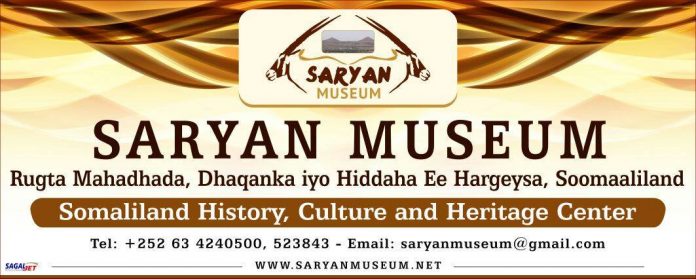by Tirsit Yetbarek Seme
Hargeisa’s Saryan Museum is a small wonder [photograph above – Ed.]. The peaceful atmosphere around the white buildings of its compound, not far from the Hargeisa Cultural Centre, in the Sha’ab neighbourhood of Somaliland’s capital, gives a feeling of nothing much happening, but the newly-growing flowers and seedling trees assure that this is a story to tell.
As yet, its two buildings, one housing a chronologically placed photo gallery of Somaliland’s historical background, the other a small but rich and diverse collection of cultural artifacts, are only just beginning to attract the attention they deserve—for now, you the visitor, are shown around by the founder, Mr Saeed Shukri Hussein, himself, whose long-harboured dream of opening the museum—the first in modern Somaliland—finally came true with the museum’s inauguration in August 2017.
Now, Saryan is very much open, and a visit should be as high on the agenda of travellers to Somaliland as one to Las Geel caves or Berbera’s beaches. The current collection, of approximately 2,500 items, includes documents of the history of Somaliland from the earliest periods, archaeological artefacts, ethnographic objects, natural history, art, books, maps, documents and numismatics. Materials have come from all over, including objects concealed or spirited away during the civil war before Somaliland’s declaration of independence in 1991, and from Saeed’s own personal collection and archive built over many years.
With Saryan, Saeed aims to fulfill the UNESCO definition of what a museum’s primary purpose is: “to safeguard and preserve the heritage as a whole. It carries out whatever scientific study is required to understand and establish both its meaning and its possession.” The museum is one of Somaliland’s few venues dedicated to historical reference and reflection. Its ambitions, as suggested by UNESCO’s definition are manifold, but rest upon a firm base—of displaying in particular the social and political background of Somaliland and the Somali National Movement (SNM), the group which fought for the rebirth of Somaliland as an independent state. Saeed is himself a SNM veteran.
Early stages
The museum is still in its early stages, and has not yet become a place inviting a visit in the minds of many. And the scale of the challenge and lack of resources is apparent in every way: it is fair to say that the cases, mountings and caption material do not yet rival the standard of the British Museum in London. But Saeed’s ambition—to collect, study, preserve and exhibit and promote the diverse culture and history of Somaliland, in order to foster a deeper understanding of, and appreciation for Somaliland’s heritage in both local and international audiences—is infectious. Especially as its establishment was a huge personal challenge, as his notion to establish a museum and invest about $375,000 was questioned by his family and friends. “Everybody was asking me the capital returns on my investment”, says Saeed, remembering the reservations, which he has managed to overcome with dedication and far-sightedness.
Saeed envisages Saryan’s future as a nationally and globally-recognised museum with an outstanding collection and programmes that help in understanding the past, appreciating the present, and embracing the future, strengthening the bonds of the community, and facilitating solutions to common problems. This is why the historical background of the SNM is given significant space: not only, he says, did the SNM achieve victory against the Siyyad Barre régime, but it demonstrated a genuine commitment to the highest form of democracy when it surrendered power to the people to govern themselves after just two years.
This courageous and unique move—something not typically done by victorious liberation movements—is, for him, a key point to be highlighted. As is the support line established between the SNM and Ethiopia—a great diplomatic victory for Ethiopia, and for the SNM, a crucial part of its success in being able to organise its operations to capture Hargeisa and Burao and gain victory.
As well as establishing safety corridors for civilians, it allowed integration between Somaliland and Ethiopia, washing away the hatred, bias and negative influences of history, he says. For these reasons, and of course his own background, he has focused on the history of the SNM and its relations with the Ethiopian government and community. “For the advantage of the Saryan Museum, I have selected this historical piece of information to educate younger generations about the political role of the SNM for the good of both internal and regional stability.”
Long way to go
With its combination of Somaliland’s material culture and the historical path and achievements of the SNM, the museum has started its journey. But there is a long way to go. Saeed reels off the many challenges he faces, including the core one: the physical collection of display material as many valuable items were neither free nor easily available. Furthermore, he says, it was not always easy to find what the museum required in specific locations. Sometimes it was necessary to travel to other regions to collect items for display. All of this comes at a cost, both in time and financial terms.
Importantly, he retains the museum’s credibility in the fight against illicit looting of precious items by discouraging the dealers in that market by clearly informing them that the museum does not procure goods in such a fashion. But it is an ongoing challenge, as is the ever-present one of fundraising to cover overhead costs: although the museum has started to advertise itself and make itself available, as yet, visitors are not used to coming and paying the small entrance fee. Training of staff for the museum and the museum’s library are also ongoing challenges.
Saeed’s strong determination and optimism that the Saryan Museum will become a crucial part of Somaliland’s national heritage is inspiring. But assistance is needed to make this happen. So, the hope is that the calls for assistance he is making will be heeded. The first call is for support and donations to stock the museum’s library, particularly with books pertaining to humanity subjects as the museum intends to facilitate resources for historical and social science fields of study regarding Somaliland. This also includes any assistance to provide publications and documents useful for readers and for the library.
The second appeal is for all the material and antiques that may now be idly sitting in living rooms and cupboards through the previous lack of display space. And of course money helps: contributions via financial donations small and large, as well as media promotion, word of mouth, and of course visitors to spread the word. This will all help Saeed and his supporters attain their mission and vision of preserving the past, exhibiting history and contemporary life and facilitating a museum that becomes an academic foundation for the future of all Somalilanders.
Tirsit Yetbarek Seme is from Addis Ababa, Ethiopia. Currently based in Hargeisa, she is undertaking a PhD in sociolinguistic communications at Addis Ababa University focusing on the Somali language. She is in charge of Academic Dialogue in Hargeisa (ADIH), a PhD dialogue organised by the Hargeisa Cultural Centre, while also helping to organise the annual Hargeisa Book Fair and volunteering at Saryan Museum. She wrote about the 2017 Hargeisa Book Fair in the Autumn 2017 Journal.
More can be found out about the Museum (including how to support its work) at www.saryanmuseum.net Saryan in Somali means (the brave, vigilant) ‘oryx’. The museum is ‘wise, independent, lonely, and thrives within a community recovering from conflict’.
SOURCE:HORNDIPLOMAT








